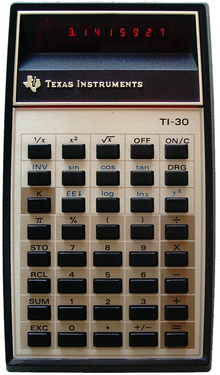
An electronic calculator is typically a portable electronic device used to perform calculations, ranging from basic arithmetic to complex mathematics.
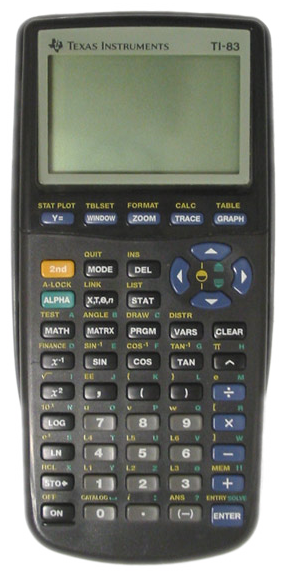
The TI-83 series is a series of graphing calculators manufactured by Texas Instruments.

A scientific calculator is an electronic calculator, either desktop or handheld, designed to perform calculations using basic and complex mathematical operations and functions. They have completely replaced slide rules as well as books of mathematical tables and are used in both educational and professional settings.

The Speak & Spell line is a series of electronic hand-held child computers by Texas Instruments that consisted of a TMC0280 linear predictive coding speech synthesizer, a keyboard, and a receptor slot to receive one of a collection of ROM game library modules. The first Speak & Spell was introduced at the summer Consumer Electronics Show in June 1978, making it one of the earliest handheld electronic devices with a visual display to use interchangeable game cartridges. The company Basic Fun brought back the classic Speak & Spell in 2019 with some minor changes.
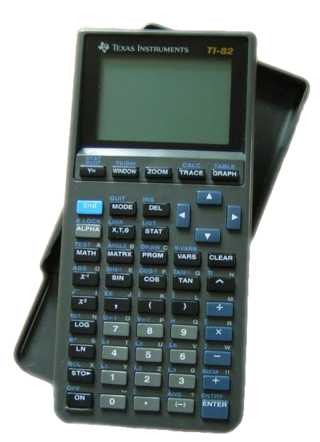
The TI-82 is a graphing calculator made by Texas Instruments. The TI-82 was designed in 1993 as a stripped down, more user friendly version of the TI-85, and as a replacement for the TI-81. It was the direct predecessor of the TI-83. It shares with the TI-85 a 6 MHz Zilog Z80 microprocessor. Like the TI-81, the TI-82 features a 96×64 pixel display, and the core feature set of the TI-81 with many new features.

The TI-81 was the first graphing calculator made by Texas Instruments. It was designed in 1990 for use in algebra and precalculus courses. Since its release, it has been superseded by a series of newer calculators: the TI-85, TI-82, TI-83, TI-86, TI-83 Plus, TI-83 Plus Silver Edition, TI-84 Plus, TI-84 Plus Silver Edition, TI-84 Plus C Silver Edition, TI-Nspire, TI-Nspire CAS, TI-84 Plus CE, and most recently, the TI-84 Plus CE Python. Most of them share the original feature set and 96×64-pixel display that began with this calculator, with the exceptions of the TI-84 Plus C Silver Edition and the TI-84 Plus CE family.
Engineering notation or engineering form (also technical notation) is a version of scientific notation in which the exponent of ten is always selected to be divisible by three to match the common metric prefixes, i.e. scientific notation that aligns with powers of a thousand, for example, 531×103 instead of 5.31×105 (but on calculator displays written without the ×10 to save space). As an alternative to writing powers of 10, SI prefixes can be used, which also usually provide steps of a factor of a thousand. On most calculators, engineering notation is called "ENG" mode as scientific notation is denoted SCI.
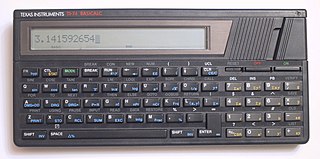
The Texas Instruments TI-74 Basicalc is a type of programmable calculator, which was released in 1985 to replace the Compact Computer 40.
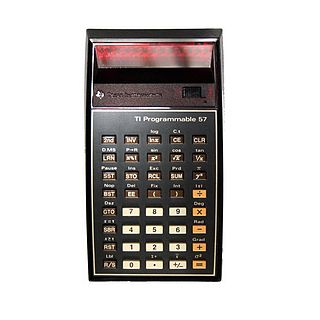
The TI-57 was a programmable calculator made by Texas Instruments between 1977 and 1982. There were three machines by this name made by TI, the first was the TI-57 with LED display released in September 1977 along the more powerful TI-58 and TI-59. It had 50 program steps and eight memory registers. Two later versions named TI-57 LCD and TI-57 LCD-II have a LCD display, but were less powerful and had much less memory: 48 bytes to be allocated between program 'steps' and storage registers.
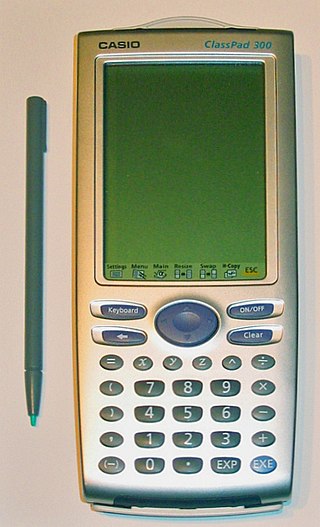
The Casio ClassPad 300, ClassPad 330 and fx-CP400 are stylus based touch-screen graphing calculators. It comes with a collection of applications that support self-study, like 3D Graph, Geometry, eActivity, Spreadsheet, etc. A large 160x240 pixel LCD touch screen enables stylus-based operation. It resembles Casio's earlier Pocket Viewer line. HP and Texas Instruments attempted to release similar pen based calculators (the HP Xpander and PET Project, but both were cancelled before release to the market.
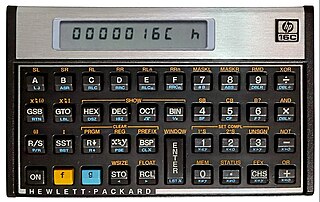
The HP-16C Computer Scientist is a programmable pocket calculator that was produced by Hewlett-Packard between 1982 and 1989. It was specifically designed for use by computer programmers, to assist in debugging. It is a member of the HP Voyager series of programmable calculators. It was the only programmer's calculator ever produced by HP, though many later HP calculators have incorporated most of the 16C's functions.
Texas Instruments TI-36 is a series of scientific calculators distributed by Texas Instruments. It currently represents the high-end model for the TI-30 product lines.

The TI-Nspire is a graphing calculator line made by Texas Instruments, with the first version released on 25 September 2007. The calculators feature a non-QWERTY keyboard and a different key-by-key layout than Texas Instruments's previous flagship calculators such as the TI-89 series.
Sharp EL-500W series include a range of scientific calculators made by Sharp Corporation, capable of displaying 2 lines, with multi-line playback. It is the successor to the Sharp EL-500V series.

Texas Instruments TI-35 was a series of scientific calculators by Texas Instruments. The original TI-35 was notable for being one of Texas Instruments' first use of CMOS controller chips in their designs, and was at the time distinguished from the lower-end TI-30 line by the addition of some statistics functions.

The Texas Instruments Business Analyst series is a product line of financial calculators introduced in 1976. BA calculators provide time value of money functions and are widely used in accounting and other financial applications. Though originally designed specifically for financial use, current models also include basic scientific calculator and statistics functions. The BA series competes directly with other mid- to high-end financial calculators, particularly the HP-12C and other models from TI competitor Hewlett-Packard. There are two models in the product line: the BA II Plus and the BA II Plus Professional.
The TI-34 name is a branding used by Texas Instruments for its mid-range scientific calculators aimed at the educational market. The first TI-34 model was introduced in 1987 as a midpoint between the TI-30 series and the TI-35/TI-36 series. Earlier models included Boolean algebra features, though these were removed with the introduction of the TI-34II in 1999, which focuses more on fractional calculations and other subjects common in middle and high school math and science curricula.

The Little Professor is a backwards-functioning calculator designed for children ages 5 to 9. Instead of providing the answer to a mathematical expression entered by the user, it generates unsolved expressions and prompts the user for the answer.

Solar-powered calculators are hand-held electronic calculators powered by solar cells mounted on the device. They were introduced at the end of the 1970s.
Casio V.P.A.M. calculators are scientific calculators made by Casio which use Casio's Visually Perfect Algebraic Method (V.P.A.M.), Natural Display or Natural V.P.A.M. input methods.
